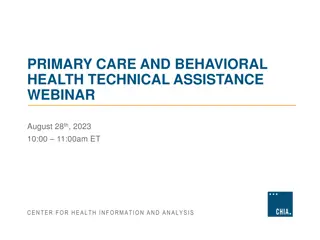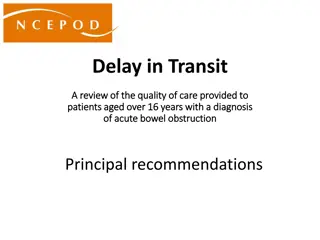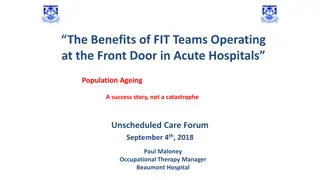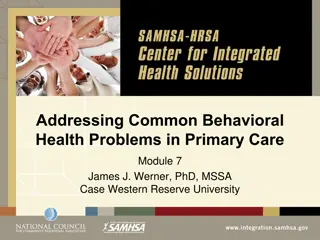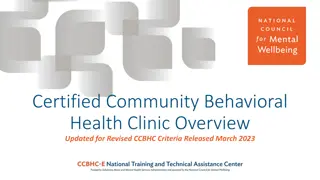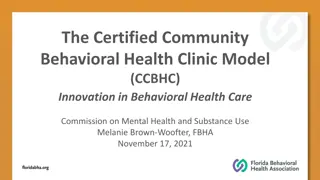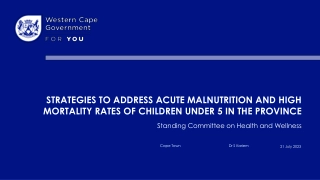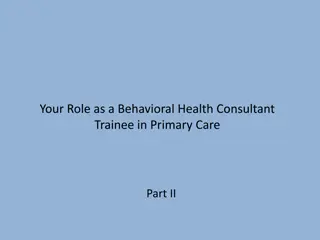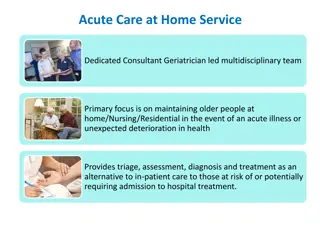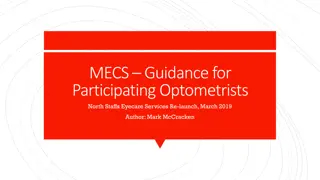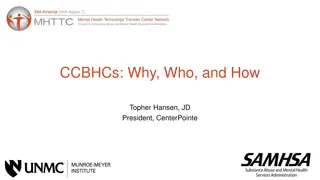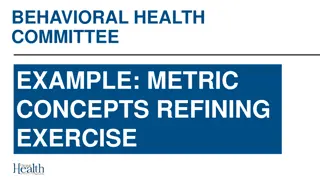Behavioral Health Readmissions in Massachusetts Acute Care Hospitals Overview
This presentation delves into the prevalence of behavioral health comorbidities and readmissions in Massachusetts acute care hospitals. It highlights the importance of addressing behavioral health conditions in hospital settings, emphasizing the need for improved discharge planning and quality improvement strategies. The data presented sheds light on the impact of mental health and substance use disorders on hospitalizations, urging healthcare professionals to consider these factors in patient care.
Download Presentation

Please find below an Image/Link to download the presentation.
The content on the website is provided AS IS for your information and personal use only. It may not be sold, licensed, or shared on other websites without obtaining consent from the author. Download presentation by click this link. If you encounter any issues during the download, it is possible that the publisher has removed the file from their server.
E N D
Presentation Transcript
Behavioral Health & Readmissions in Massachusetts Acute Care Hospitals November 17, 2016
Overview Introduction Why behavioral health? What are some of the key findings? What are some of the implications for practice and quality improvement? Questions & Answers 2
CHIAs All-Payer Readmission Analyses Medicare Fee-For-Service vs. all-payer population CHIA s adaptation of the Yale/CMS hospital-wide all cause unplanned readmission for the all-payer population first public reporting in June 2015 Statewide reports and hospital-specific readmissions profiles Expansion to include primary psychiatric discharges to look at behavioral health comorbidity 3
Overview Introduction Why behavioral health? What are some of the key findings? What are some of the implications for practice and quality improvement? Questions & Answers 4
Why Behavioral Health? One in four adults suffers from a behavioral health condition. One-third of all hospitalizations involved individuals with a comorbid behavioral health diagnosis. New discharge planning requirements to include behavioral health for all Medicare and Medicaid patients. First statewide, all-payer examination of the prevalence of behavioral health comorbidities and readmissions among hospitalized adults in Massachusetts acute care hospitals. 5
Counting Eligible Discharges (FY2014 #s) HDD Adult Discharges 677,379 Missing/invalid SSN Transfers Deaths in hospital Against medical advice Remove discharges that don t make sense to include Remove discharges for certain specialized types of care Obstetric Cancer Rehabilitation Eligible Discharges 515,353 Unique Patients 347,747 6
Behavioral Health Comorbidity Using a modified AHRQ methodology, both primary and secondary diagnoses across all discharges for patients within the one-year study period were used to classify patients into four mutually exclusive groups: Mental health disorders (MD) only Substance use disorders (SUD) only Both MD and SUD or co-occurring disorders (COD) No mention of MD or SUD (None) 7
Overview Introduction Why behavioral health? What are some of the key findings? What are some of the implications for practice and quality improvement? Questions & Answers 8
Statewide Prevalence of Behavioral Health Comorbidity among Patients in Acute Care Hospitals 9
Statewide Readmission Rates and Behavioral Health Comorbidity 10
Prevalence of Behavioral Health Comorbidity by Age Group 11
Readmission Rates and Behavioral Health Comorbidity by Age Group 12
Prevalence of Behavioral Health Comorbidity by Payer Type 13
Readmission Rates and Behavioral Health Comorbidity by Payer Type 14
Readmission Rates and Behavioral Health Comorbidity by Common Discharge Diagnosis 15
Summary of Findings 40% of hospitalized patients had at least one comorbid behavioral health condition. Patients with behavioral health comorbidity 77% more likely to be readmitted than those without any behavioral health comorbidity (20.2% vs. 11.4%). 61% of hospitalized Medicaid patients had a comorbid behavioral health condition. Medicaid patients with comorbid co-occurring mental and substance use conditions were three times more likely to be readmitted than those without any behavioral health comorbidity (26.6% vs. 9.0%). Young adults (age 18-44) with a behavioral health comorbidity were nearly three times more likely to be readmitted than those without any behavioral health comorbidity (18.0% vs. 6.5%). Among patients discharged with heart failure, the presence of a behavioral health comorbidity was associated with a readmission rate that was 56% higher than those without any behavioral health comorbidity (29.4% vs. 18.9%). 16
Overview Introduction Why behavioral health? What are some of the key findings? What are some of the implications for practice and quality improvement? Questions & Answers 17
Implications for Practice & Quality Improvement Amy E. Boutwell, MD, MPP
Why are these findings important? 61 man with 8 hospitalizations for shortness of breath. Oh honey, I m in here every couple of weeks and it always takes about 5 days to tune me up 32M with lifetime of uncontrolled diabetes. I need housing, not a shelter. I need someone to help make sure I take my medicines. In a shelter they don't do that and they kick you out every morning. I need a stable residence and no one is able to help with that." 2
AHRQ Reducing Medicaid Readmissions Project Identify the similarities & differences in readmission patterns for Medicare v. Medicaid patients Explore whether the best practices to reduce readmissions apply to the Medicaid population as well Create a guide for hospitals to increase awareness of the unique issues in reducing Medicaid readmissions 3
The guide comes with 13 customizable tools to be used in hospital teams day-to-day operations. 4
The ASPIRE Framework Analyze Your Data A Analysis Survey Your Current Readmission Reduction Efforts S Plan a Multi-faceted, Data-Informed Portfolio of Strategies P Reduce Medicaid Readmissions Implement Whole-Person Transitional Care for All I Action Reach Out and Collaborate with Cross-Continuum Providers R Enhance Services for High-Risk Patients E 5
Teams with Results Know their data Analyze, trend, track, display, share, post Broad concept of readmission risk Way beyond case finding for diagnoses Multifaceted strategy Improve standard care, collaborate across settings, enhanced care Use technology to make this better, quicker, automated Automated notifications, implementation tracking, dashboards 6
Examples: Data-informed Socially Complex Criteria Adult, non-OB Medicaid patient Medicare <65 Substance use disorder High utilization (4+ admissions/12 months) Whole-hospital readmission rate: 13% Socially complex population readmission rate: 37% That s data-informed targeting! 7
Designing Services for High Risk Target Populations There may be several target populations at high risk of readmission identified by your data analyses Consider the following high risk target populations: Adults with behavioral health comorbidities; Adults residing in group homes or other residential settings; Adults with a personal history of repeated hospitalizations in the past year One standard transitional care model would not likely meet the needs and address the root causes of readmissions for all these populations Design enhanced services to meet the needs of each target population 8
Social Work-Provided Transitional Care Assess whole-person needs Anticipates needs will change over time Repeated assessments Customized interventions Link individuals to existing providers and services - 20% reduction - All hospital - All cause - At Scale (1500+) Provide psycho-therapeutic support Identify person-centered priorities and goals Advocate for timely services, patient preferences, etc. Boutwell et at JAGS May 2016 9
Whole-Person Adaptations to Transitional Care Navigating Hand-holding Arranging for . Providing with . Harm reduction Meet where they are Patient priorities first Relationship-based 11
Summary Know your data use it as a powerful tool Constantly work to understand why patients return to the hospital Design services that will meet the needs of specific target populations For people with behavioral health comorbidities, deploy care teams that actively do for navigate, advocate, support Don t over-medicalize readmissions or hospital utilization It is possible to meaningfully improve care and reduce readmissions for people with behavioral health conditions! 12
THANK YOU! Questions? chia.webmaster@MassMail.State.MA.US




